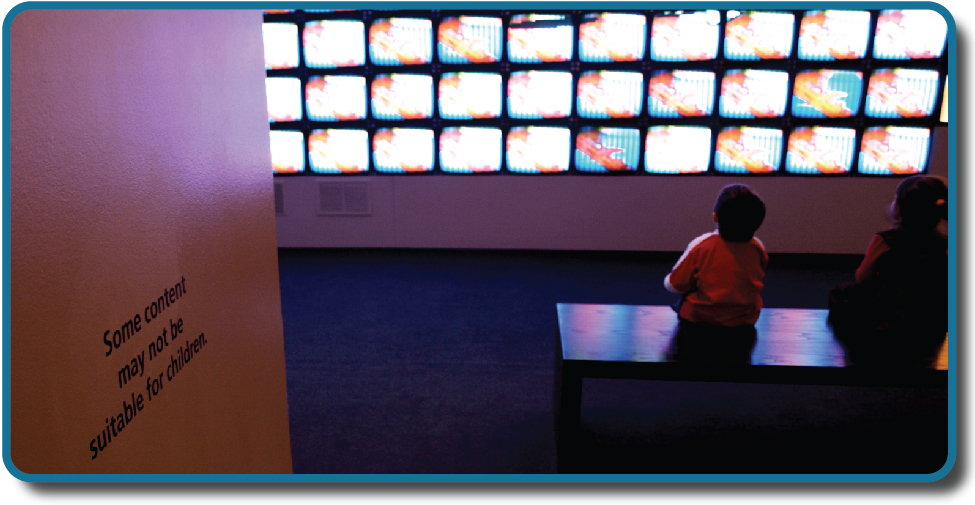2.1: 心理研究前奏
- Page ID
- 203413
学习目标
- 了解研究的重要性

你有没有想过你在电视上看到的暴力是否会影响你的行为? 在屏幕上看到人们在戏剧性场景中的暴力行为之后,你是否更有可能在现实生活中表现出激进的行为? 或者,看到虚构的暴力真的会让你的系统失去侵略性,让你变得更加和平吗? 孩子们如何受到他们所接触的媒体的影响? 对行为与暴露于暴力图像之间的关系感兴趣的心理学家可能会问这些问题。
当今媒体中的暴力话题是有争议的。 自古以来,人类就一直担心新技术对我们的行为和思维过程的影响。 例如,希腊哲学家苏格拉底担心写作(当时的新技术)会削弱人们的记忆能力,因为他们可以依靠书面记录而不是将信息写入记忆。 在我们技术日新月异的世界中,有关媒体影响的问题不断浮出水面。 我们中的许多人发现自己对这些问题有强烈的看法,却发现我们旁边的人持相反的观点。
我们怎样才能找到不仅由观点支持,而且有我们所有人都能达成共识的证据支持的答案? 心理学研究的发现可以帮助我们解决这样的问题。
References
American Academy of Pediatrics, American Academy of Child & Adolescent Psychiatry, American Psychological Association, American Medical Association, American Academy of Family Physicians, American Psychiatric Association. (2000). Joint statement on the impact of entertainment violence on children. Retrieved from www2.aap.org/advocacy/releases/jstmtevc.htm.
American Cancer Society. (n.d.). History of the cancer prevention studies. Retrieved from www.cancer.org/research/resea...evention-study
American Psychological Association. (2009). Publication Manual of the American Psychological Association (6th ed.). Washington, DC: Author.
American Psychological Association. (n.d.). Research with animals in psychology. Retrieved from www.apa.org/research/respons...ch-animals.pdf
Arnett, J. (2008). The neglected 95%: Why American psychology needs to become less American. American Psychologist, 63(7), 602–614.
Barton, B. A., Eldridge, A. L., Thompson, D., Affenito, S. G., Striegel-Moore, R. H., Franko, D. L., . . . Crockett, S. J. (2005). The relationship of breakfast and cereal consumption to nutrient intake and body mass index: The national heart, lung, and blood institute growth and health study. Journal of the American Dietetic Association, 105(9), 1383–1389. Retrieved from http://dx.doi.org/10.1016/j.jada.2005.06.003
Chwalisz, K., Diener, E., & Gallagher, D. (1988). Autonomic arousal feedback and emotional experience: Evidence from the spinal cord injured. Journal of Personality and Social Psychology, 54, 820–828.
Clayton, R. R., Cattarello, A. M., & Johnstone, B. M. (1996). The effectiveness of Drug Abuse Resistance Education (Project DARE): 5-year follow-up results. Preventive Medicine: An International Journal Devoted to Practice and Theory, 25(3), 307–318. doi:10.1006/pmed.1996.0061
D.A.R.E. (n.d.). D.A.R.E. is substance abuse prevention education and much more! [About page] Retrieved from www.dare.org/about-d-a-r-e/
Dominus, S. (2011, May 25). Could conjoined twins share a mind? New York Times Sunday Magazine. Retrieved from www.nytimes.com/2011/05/29/ma....html?_r=5&hp&
Ennett, S. T., Tobler, N. S., Ringwalt, C. L., & Flewelling, R. L. (1994). How effective is drug abuse resistance education? A meta-analysis of Project DARE outcome evaluations. American Journal of Public Health, 84(9), 1394–1401. doi:10.2105/AJPH.84.9.1394
Fanger, S. M., Frankel, L. A., & Hazen, N. (2012). Peer exclusion in preschool children’s play: Naturalistic observations in a playground setting. Merrill-Palmer Quarterly, 58, 224–254.
Fiedler, K. (2004). Illusory correlation. In R. F. Pohl (Ed.), Cognitive illusions: A handbook on fallacies and biases in thinking, judgment and memory (pp. 97–114). New York, NY: Psychology Press.
Frantzen, L. B., Treviño, R. P., Echon, R. M., Garcia-Dominic, O., & DiMarco, N. (2013). Association between frequency of ready-to-eat cereal consumption, nutrient intakes, and body mass index in fourth- to sixth-grade low-income minority children. Journal of the Academy of Nutrition and Dietetics, 113(4), 511–519.
Harper, J. (2013, July 5). Ice cream and crime: Where cold cuisine and hot disputes intersect. The Times-Picaune. Retrieved from www.nola.com/crime/index.ssf/...where_hot.html
Jenkins, W. J., Ruppel, S. E., Kizer, J. B., Yehl, J. L., & Griffin, J. L. (2012). An examination of post 9-11 attitudes towards Arab Americans. North American Journal of Psychology, 14, 77–84.
Jones, J. M. (2013, May 13). Same-sex marriage support solidifies above 50% in U.S. Gallup Politics. Retrieved from http://www.gallup.com/poll/162398/se...ies-above.aspx
Kobrin, J. L., Patterson, B. F., Shaw, E. J., Mattern, K. D., & Barbuti, S. M. (2008). Validity of the SAT for predicting first-year college grade point average (Research Report No. 2008-5). Retrieved from research.collegeboard.org/si...nt-average.pdf
Lewin, T. (2014, March 5). A new SAT aims to realign with schoolwork. New York Times. Retreived from www.nytimes.com/2014/03/06/ed...ege-board.html.
Lowcock, E. C., Cotterchio, M., Anderson, L. N., Boucher, B. A., & El-Sohemy, A. (2013). High coffee intake, but not caffeine, is associated with reduced estrogen receptor negative and postmenopausal breast cancer risk with no effect modification by CYP1A2 genotype. Nutrition and Cancer, 65(3), 398–409. doi:10.1080/01635581.2013.768348
Lowry, M., Dean, K., & Manders, K. (2010). The link between sleep quantity and academic performance for the college student. Sentience: The University of Minnesota Undergraduate Journal of Psychology, 3(Spring), 16–19. Retrieved from http://www.psych.umn.edu/sentience/f...IENCE_Vol3.pdf
Lynam, D. R., Milich, R., Zimmerman, R., Novak, S. P., Logan, T. K., Martin, C., . . . Clayton, R. (1999). Project DARE: No effects at 10-year follow-up. Journal of Consulting and Clinical Psychology, 67(4), 590–593. doi:10.1037/0022-006X.67.4.590
McKie, R. (2010, June 26). Chimps with everything: Jane Goodall’s 50 years in the jungle. The Guardian. Retrieved from www.theguardian.com/science/2...rica-interview
Offit, P. (2008). Autism's false prophets: Bad science, risky medicine, and the search for a cure. New York: Columbia University Press.
Perkins, H. W., Haines, M. P., & Rice, R. (2005). Misperceiving the college drinking norm and related problems: A nationwide study of exposure to prevention information, perceived norms and student alcohol misuse. J. Stud. Alcohol, 66(4), 470–478.
Rimer, S. (2008, September 21). College panel calls for less focus on SATs. The New York Times. Retrieved from www.nytimes.com/2008/09/22/ed...ions.html?_r=0
Ringwalt, C., Ennett, S. T., & Holt, K. D. (1991). An outcome evaluation of Project DARE (Drug Abuse Resistance Education). Health Education Research, 6(3), 327–337. doi:10.1093/her/6.3.327
Rothstein, J. M. (2004). College performance predictions and the SAT. Journal of Econometrics, 121, 297–317.
Rotton, J., & Kelly, I. W. (1985). Much ado about the full moon: A meta-analysis of lunar-lunacy research. Psychological Bulletin, 97(2), 286–306. doi:10.1037/0033-2909.97.2.286
Santelices, M. V., & Wilson, M. (2010). Unfair treatment? The case of Freedle, the SAT, and the standardization approach to differential item functioning. Harvard Education Review, 80, 106–134.
Sears, D. O. (1986). College sophomores in the laboratory: Influences of a narrow data base on social psychology’s view of human nature. Journal of Personality and Social Psychology, 51, 515–530.
Tuskegee University. (n.d.). About the USPHS Syphilis Study. Retrieved from www.tuskegee.edu/about_us/cen...lis_study.aspx.


